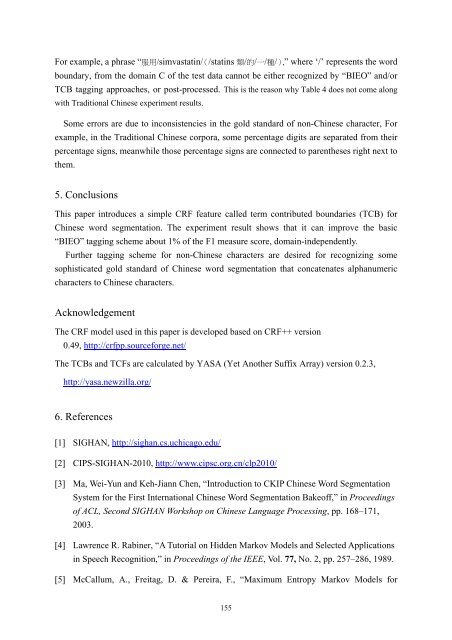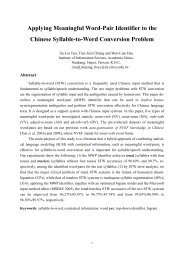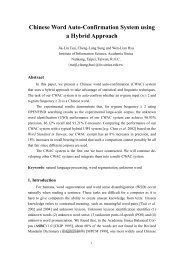Term Contributed Boundary Feature using ... - Academia Sinica
Term Contributed Boundary Feature using ... - Academia Sinica
Term Contributed Boundary Feature using ... - Academia Sinica
You also want an ePaper? Increase the reach of your titles
YUMPU automatically turns print PDFs into web optimized ePapers that Google loves.
For example, a phrase “ 服 用 /simvastatin/(/statins 類 / 的 / 一 / 種 /),” where ‘/’ represents the word<br />
boundary, from the domain C of the test data cannot be either recognized by “BIEO” and/or<br />
TCB tagging approaches, or post-processed. This is the reason why Table 4 does not come along<br />
with Traditional Chinese experiment results.<br />
Some errors are due to inconsistencies in the gold standard of non-Chinese character, For<br />
example, in the Traditional Chinese corpora, some percentage digits are separated from their<br />
percentage signs, meanwhile those percentage signs are connected to parentheses right next to<br />
them.<br />
5. Conclusions<br />
This paper introduces a simple CRF feature called term contributed boundaries (TCB) for<br />
Chinese word segmentation. The experiment result shows that it can improve the basic<br />
“BIEO” tagging scheme about 1% of the F1 measure score, domain-independently.<br />
Further tagging scheme for non-Chinese characters are desired for recognizing some<br />
sophisticated gold standard of Chinese word segmentation that concatenates alphanumeric<br />
characters to Chinese characters.<br />
Acknowledgement<br />
The CRF model used in this paper is developed based on CRF++ version<br />
0.49, http://crfpp.sourceforge.net/<br />
The TCBs and TCFs are calculated by YASA (Yet Another Suffix Array) version 0.2.3,<br />
http://yasa.newzilla.org/<br />
6. References<br />
[1] SIGHAN, http://sighan.cs.uchicago.edu/<br />
[2] CIPS-SIGHAN-2010, http://www.cipsc.org.cn/clp2010/<br />
[3] Ma, Wei-Yun and Keh-Jiann Chen, “Introduction to CKIP Chinese Word Segmentation<br />
System for the First International Chinese Word Segmentation Bakeoff,” in Proceedings<br />
of ACL, Second SIGHAN Workshop on Chinese Language Processing, pp. 168–171,<br />
2003.<br />
[4] Lawrence R. Rabiner, “A Tutorial on Hidden Markov Models and Selected Applications<br />
in Speech Recognition,” in Proceedings of the IEEE, Vol. 77, No. 2, pp. 257–286, 1989.<br />
[5] McCallum, A., Freitag, D. & Pereira, F., “Maximum Entropy Markov Models for




